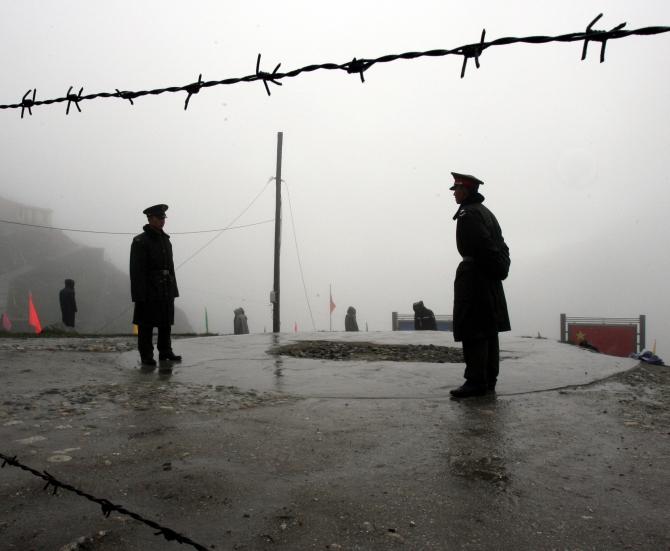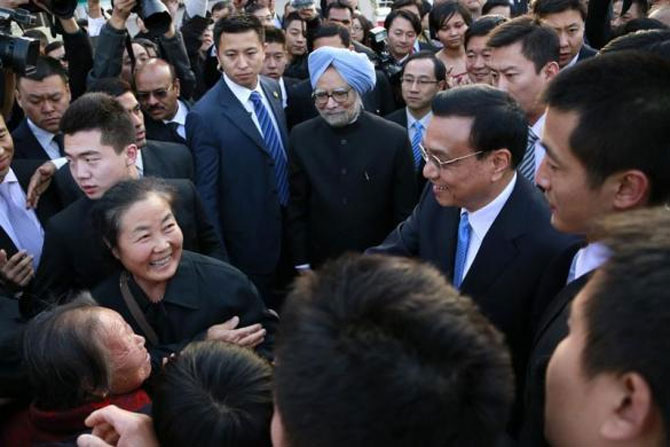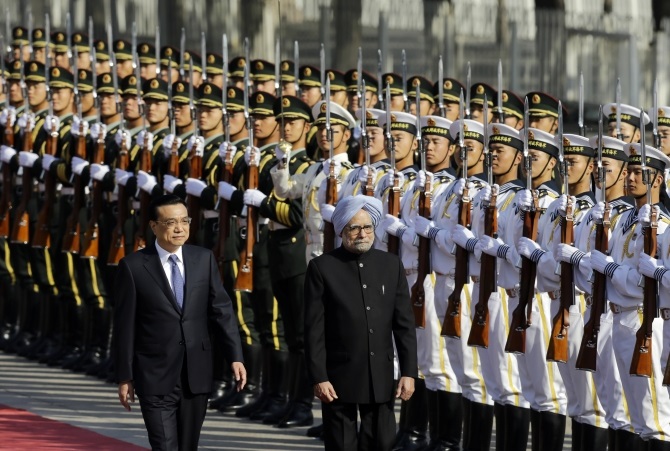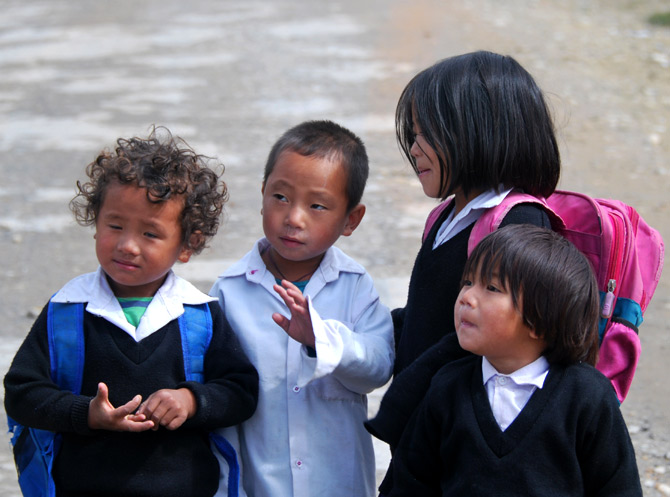 | « Back to article | Print this article |
Roller coaster year for Sino-India ties
Border stand-offs... a $30 billion trade deficit... stapled visas... the India-China relationship this year has had its rocky moments. PTI's K J M Varma surveys the Sino-India landscape in 2013.
The relationship between India and China experienced both highs and lows in 2013 with high-level reciprocal visits and the inking of a pact to defuse recurring border stand-offs after incursions by Chinese troops dented bilateral ties.
Notwithstanding tensions, the prime ministers of both countries paid back-to-back visits for the first time in nearly six decades.
Chinese Premier Li Keqiang visited New Delhi in April and Prime Minister Manmohan Singh travelled to Beijing in October.
The last time such reciprocal visits took place was in 1954 when Premier Zhou Enlai and Jawaharlal Nehru visited each other's countries.
Li and Dr Singh's visits were regarded as a landmark and the two sides tried to recreate the warmth and friendship which had evaporated after the 1962 war.
The significance of Li's decision to make India his first destination after taking over office was in danger of losing its importance when Chinese troops pitched their tents in the Depsang valley in Ladakh in April.
However, the prickly issue was resolved through intense talks which led to the withdrawal of the Chinese troops.
Li's goodwill tour was fairly successful with the Chinese leader seeking to assuage frayed tempers.
The impact of Li's visit was felt during Dr Singh's trip to Beijing when the Chinese leadership displayed considerable warmth.
Kindly click Next to read more...
Roller coaster year for Sino-India ties
During Dr Singh's three-day visit the two sides signed the Border Defence Cooperation Agreement, BDCA, which provided a comprehensive mechanism to address issues arising out of the patrolling of the disputed border.
The agreement, aimed at reducing future frictions at the border, could provide a new opening to push forward relations.
Besides the BDCA, the militaries of the two countries resumed joint military exercises after five years.
Dr Singh's visit was marked by informality as he was hosted a lunch by former premier Wen Jiabao. Li took Dr Singh for a walk around the Forbidden City, both being unique symbolic gestures.
Kindly click Next to read more...
Roller coaster year for Sino-India ties
Soon after taking over power in March, President Xi Jinping, who emerged as a strong leader holding the troika of power centres -- the head of the ruling Communist Party of China, the presidency and the chief of the People's Liberation Army -- unveiled a five-point formula to improve ties with India.
Xi proposed accommodation of each other's core concerns and proper handling of differences while seeking peace on the border as the two sides worked for a resolution of the dispute.
The five proposals included bilateral cooperation in infrastructure, mutual investment, collaboration in multilateral fora to protect the interest of developing countries and tackling global challenges.
"The border question is a complex issue left from history and solving the issue won't be easy. However, as long as we keep up friendly consultations, we can eventually arrive at a fair, reasonable and mutually acceptable settlement," Xi said in an interview to PTI.
Kindly click Next to read more...
Roller coaster year for Sino-India ties
During his visit in October, Prime Minister Singh had the rare honour of addressing the Communist party's Central School in Beijing where he identified eight areas of cooperation and proposed seven practical principles of engagement to set India-China relations on the path of progress.
His proposals included sensitivity to mutual core concerns while maintaining peace and tranquillity in the India-China border areas, which he said has been the 'cornerstone' of the relationship.
Another interesting point Dr Singh made was to allay apprehensions about India's engagement with the US, Japan and other countries in the Asia Pacific region while highlighting concerns in India about China's strategic 'all weather' relationship with Pakistan.
Kindly click Next to read more...
Roller coaster year for Sino-India ties
An important achievement this year from India's point of view was the agreement on strengthening cooperation on trans-border rivers under which China has agreed to provide additional 15 days of flood season data of the Brahmaputra river.
India has been highlighting its concerns over China building several dams on the river in Tibet as it could restrict the water flows.
The data will help India have an idea of the river water flows.
China has been assuring India that it is alive to its concerns and its dams are rung of the river projects and would not hold water.
The bilateral relationship also witnessed its share of lows as apart from instances of Chinese incursions the two countries missed out on a big opportunity to sign agreements to liberalise the visa regime which could benefit them, especially in the investment sector.
Differences between the two sides came to the fore when China continued its policy to issue visas on paper to residents of Arunachal Pradesh, which China claims as Southern Tibet.
A controversy was generated in October by China's decision to grant visas on paper to two archers from Arunachal Pradesh.
India lodged a protest with China on the issue, terming the move 'unsavoury and unacceptable.'
India objects to the issuance of stapled visas for any of its nationals wanting to proceed to China.
China's stapled visa policy has prevented residents from Arunachal Pradesh from travelling to that country, making it a contentious issue in bilateral relations.
Over 600,000 Indians visited China in 2012 displaying growing interest about China in India, but only over 100,000 Chinese visited India, which shows India has to do a lot to attract more Chinese tourists.
The two countries plan to step up bilateral trade to $100 billion by 2015 from the present over $66 billion.
Kindly click Next to read more...
Roller coaster year for Sino-India ties
India has been highlighting its concerns over the $30 billion trade deficit and asking for a major opening for India's information technology and pharmaceutical industries.
While promising to address the trade deficit issue, China is also looking to step up investments in India to generate more business as well as jobs.
India has agreed in principle to set up Chinese investment parks. Chinese officials are currently visiting India to identify appropriate locations for the projects.
Trade cooperation is one of the pillars of the bilateral relationship and both countries are expected to benefit from the Bangladesh, China, India, Myanmar trade corridor Premier Li proposed during his visit to India.





